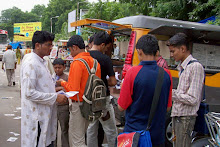Indian
Express: Mumbai: Wednesday, 10 December 2014.
DESPITE a
substantial increase in the education budget over the last five years, the
Brihanmumbai Municipal Corporation (BMC) has failed to check dropout rates,
reveals a white paper on the “status of municipal education in Mumbai”,
released by NGO Praja Foundation Tuesday. The dropout rate, according to the
paper, has gone up from six (out of 100 students) in 2009-10 to 12 in 2013-14.
Overall,
there has been an 11 per cent overall drop in the number of children in BMC
schools, said the survey. According to data sought by Praja under RTI, 51,649
students have dropped out of municipal schools in the city since 2009-10 and
there has been a 41 per cent drop in new enrollments to class I.
The data
shows that 67,477 students had enrolled for class I in the year 2009-10, but
only 53,056 made it till class VII in 2013-14. Based on this data, the
organisation has estimated that only 63.6 per cent of students who enrolled in
class I in 2009-10 are likely to make it to class VII in 2015-16. “If we do not
address this immediately and if this sort of trend continues, then we might not
have children in municipal schools. Though BMC proudly claims that they give 27
free items to children every year, what they actually don’t provide is quality
education, which is why the retention rate is constantly reducing every single
year,” said Nitai Mehta, founder and managing trustee, Praja Foundation.
Their
research shows that the dropout rates for Hindi and Urdu medium schools have
increased significantly in the last five years. From 9.6 per cent in 2009-10
for Hindi medium schools, the dropout rate increased to 17 per cent in 2013-14.
Further, in Urdu medium schools, the dropout rate went up from six per cent in
2009-10 to 13.1 per cent in 2013-14. Barring English medium, enrollments across
all other mediums of instruction have declined in 2013-14, the report claimed.
“As soon as there is a slight change in the economic status of a family, they
migrate towards private schools because the quality of education has dropped
drastically,” said Milind Mhaske, project director, Praja.
Mhaske added
that though BMC has doubled the budget for education over the last five years,
there have not been any significant changes. The total budget allocated for
49,179 students in 2009-10 was Rs 1,255 crore, which increased to Rs 2,870 for
404,251 students in 2014-15.
The paper,
which has also compared the performance of students from BMC schools as against
students from private aided, unaided and unrecognized schools, shows that 1.3
per cent students from BMC schools passed the scholarship exams held in class
IV as against 9.4 per cent from other schools. While the SSC passout percentage
in BMC stands at 67 per cent, it is 83 per cent in other schools.
According to
the household survey commissioned by Praja, with a sample size of 22,580
households in the city, 63 per cent of the parents were not happy with the
“quality of education” in municipal schools, while 44 per cent said that the
teachers in BMC schools are not good. Further, while 36 per cent said that the
infrastructure facilities provided to students was not good, 33 per cent said
that other facilities provided to students in municipal schools were not good.
Refuting the
claims made by Praja, BMC’s education committee chairman Vinod Shelar said, “We
do not know the authenticity of the data collected by Praja. But BMC provides
27 free items to students because most of them come from weaker sections of the
society and cannot afford to pay so much. The BMC is also taking every possible
step in ensuring quality education for the students.”














































































